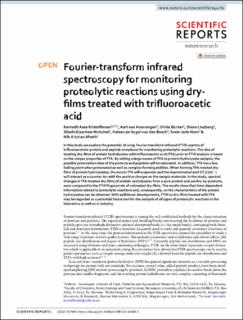| dc.contributor.author | Kristoffersen, Kenneth Aase | |
| dc.contributor.author | van Amerongen, Aart | |
| dc.contributor.author | Böcker, Ulrike | |
| dc.contributor.author | Lindberg, Diana | |
| dc.contributor.author | Wubshet, Sileshi Gizachew | |
| dc.contributor.author | de Vogel-van den Bosch, Heleen | |
| dc.contributor.author | Horn, Svein Jarle | |
| dc.contributor.author | Afseth, Nils Kristian | |
| dc.date.accessioned | 2020-11-11T10:31:38Z | |
| dc.date.available | 2020-11-11T10:31:38Z | |
| dc.date.created | 2020-07-27T10:24:14Z | |
| dc.date.issued | 2020 | |
| dc.identifier.citation | Scientific Reports, 2020, 10, 7844 | en_US |
| dc.identifier.issn | 2045-2322 | |
| dc.identifier.uri | https://hdl.handle.net/11250/2687329 | |
| dc.description.abstract | In this study we explore the potential of using Fourier-transform infrared (FTIR) spectra of trifluoroacetate-protein and peptide complexes for monitoring proteolytic reactions. The idea of treating dry-films of protein hydrolysates with trifluoroacetic acid (TFA) prior to FTIR analysis is based on the unique properties of TFA. By adding a large excess of TFA to protein hydrolysate samples, the possible protonation sites of the proteins and peptides will be saturated. In addition, TFA has a low boiling point when protonated as well as complex-forming abilities. When forming TFA-treated dry-films of protein hydrolysates, the excess TFA will evaporate and the deprotonated acid (CF3COO−) will interact as a counter ion with the positive charges on the sample materials. In the study, spectral changes in TFA-treated dry-films of protein hydrolysates from a pure protein and poultry by-products, were compared to the FTIR fingerprints of untreated dry-films. The results show that time-dependent information related to proteolytic reactions and, consequently, on the characteristics of the protein hydrolysates can be obtained. With additional developments, FTIR on dry-films treated with TFA may be regarded as a potential future tool for the analysis of all types of proteolytic reactions in the laboratory as well as in industry. | en_US |
| dc.language.iso | eng | en_US |
| dc.rights | Attribution-NonCommercial-NoDerivatives 4.0 Internasjonal | * |
| dc.rights.uri | http://creativecommons.org/licenses/by-nc-nd/4.0/deed.no | * |
| dc.title | Fourier-transform infrared spectroscopy for monitoring proteolytic reactions using dry-films treated with trifluoroacetic acid | en_US |
| dc.type | Peer reviewed | en_US |
| dc.type | Journal article | en_US |
| dc.description.version | publishedVersion | en_US |
| dc.source.pagenumber | 10 | en_US |
| dc.source.volume | 10 | en_US |
| dc.source.journal | Scientific Reports | en_US |
| dc.identifier.doi | 10.1038/s41598-020-64583-3 | |
| dc.identifier.cristin | 1820558 | |
| dc.relation.project | Nofima AS: 201701 | en_US |
| dc.relation.project | Norges forskningsråd: 262300 | en_US |
| dc.relation.project | Nofima AS: 201702 | en_US |
| dc.relation.project | Norges forskningsråd: 262308 | en_US |
| dc.relation.project | Norges forskningsråd: 280709 | en_US |
| dc.relation.project | Nofima AS: 12336 | en_US |
| dc.source.articlenumber | 7844 | en_US |
| cristin.ispublished | true | |
| cristin.fulltext | original | |
| cristin.qualitycode | 1 | |

